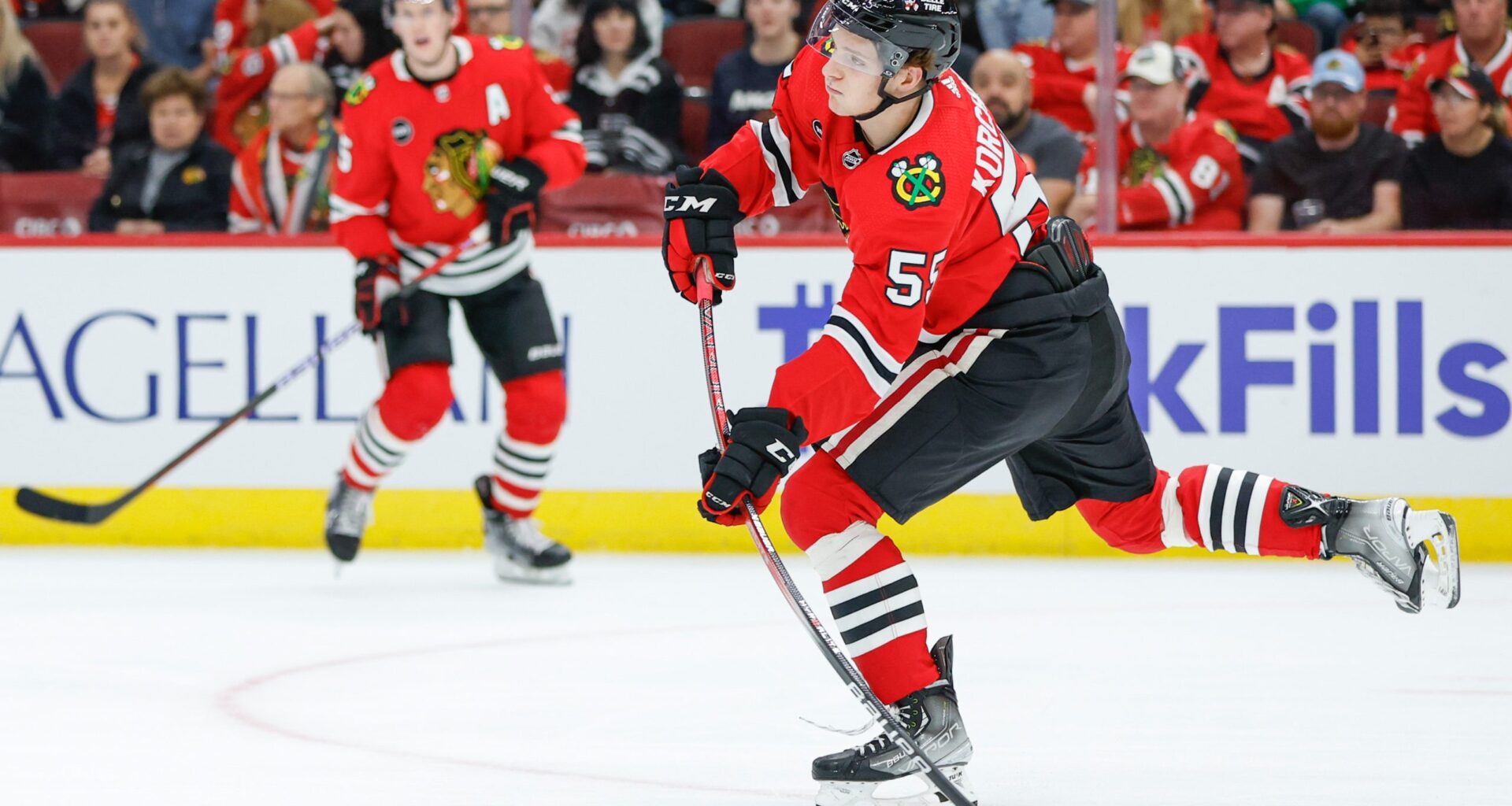Welcome back to The Journey, where we track the development of prospects as they excel in junior, make the NHL, and push towards stardom.
This week we are looking at a group of players who, for different reasons, did not take the step forward many expected in 2024-2025. Some plateaued, some struggled with consistency, and some simply failed to separate themselves in crowded systems. In a few cases, their stock even dipped as newer names passed them on depth charts.
Either way, the 2025-2026 season presents a pivotal opportunity. This is their chance to bounce back, reassert themselves as top prospects, and prove they still belong in long term NHL plans. You can certainly see each case as a buy-low opportunity, that is, assuming their stock raises once again.
Terik Parascak (F, Washington Capitals)
Parascak burst onto the scene with a monster draft year in 2023-24, piling up points at a rate of 1.54 points per game. In 2024-25, he regressed to just 1.39 points per game, even though the Prince George Cougars were still a strong team. His offensive instincts remain legitimate, but he needs to diversify his attack and show more impact without the puck.
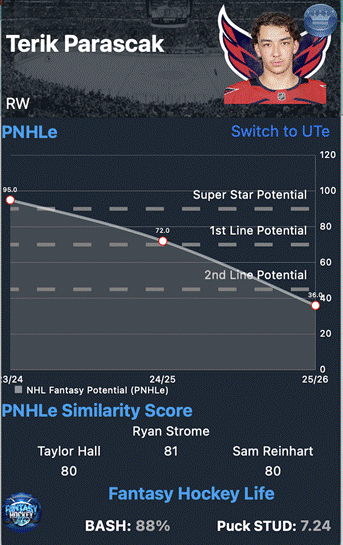
In the NHL Rank King application, his pNHLe cratered from a high of 94 to just 38. Entering his third and (likely) final WHL season, he needs to re-establish himself as a high-end producer. For the Capitals, this year will determine whether Parascak is a true top-six candidate or more of a secondary scorer. Dynasty managers should temper immediate expectations but not lose sight of his upside. If he adds more dimension to his game and proves he can drive play rather than simply finish it, a rebound season could quickly restore his trajectory.
Trevor Connelly (F, Vegas Golden Knights)
Connelly entered 2024-25 with major hype thanks to his creativity, skating, and dynamic offensive skill set, but his season at Providence was not the breakout many expected. While he showed flashes of high-end talent, long stretches of quiet play raised concerns about his consistency and ability to impact games shift to shift. Against stronger competition, he sometimes struggled to impose himself and faded into the background instead of driving play.
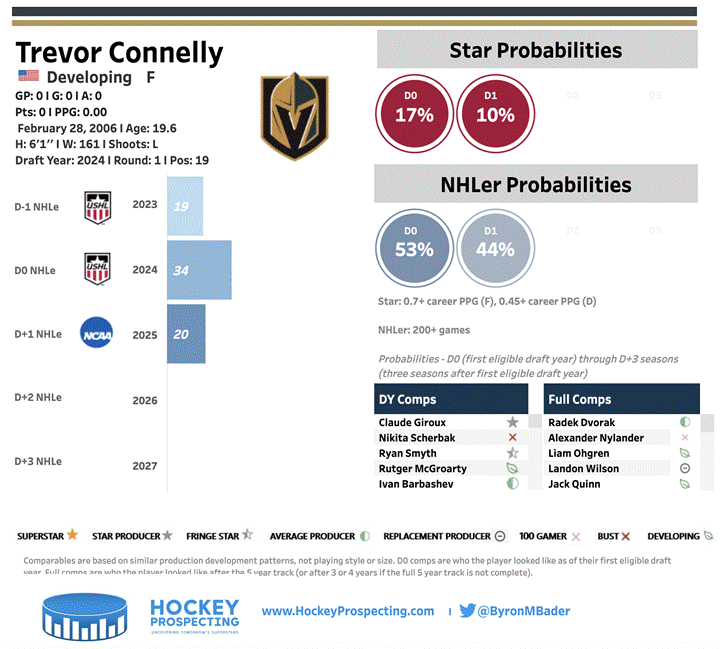
He did look better during a brief stint in the AHL at the end of the season, which offered a glimpse of how his game might translate at the pro level. Still, the jump to full-time professional hockey in 2025-26 will be steep, and he needs to prove he can handle the pace and physicality. His Hockey Prospecting profile backs up the narrative, as both his star potential and NHLer probability declined after his NCAA season. His upside remains that of a top-six winger with fantasy relevance, but this season will determine whether he becomes a core piece of Vegas’ future or settles in as more of a complementary scorer.
Joshua Roy (F, Montreal Canadiens)
Roy’s offensive toolkit is obvious, as he can shoot, pass, and process the game quickly, but questions about his pace and consistency continue to limit his opportunities. At times, he has struggled to match the demands of the professional game, which stalled his development and left him back in the AHL to start 2025-26. His pNHLe trend in the NHL Rank King application clearly shows a gradual downward trajectory over the past three seasons, highlighting the urgency for him to reset his value. Despite playing twenty five NHL games over the past three seasons, he must now prove that he is too good for the AHL, or risk getting passed by completely.
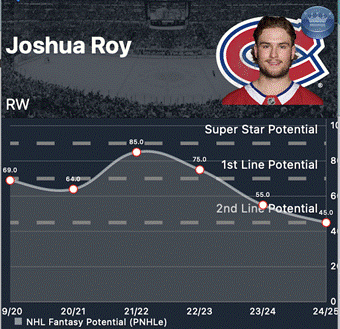
For Montreal, Roy still profiles as a potential middle six contributor, but the clock is ticking. The Canadiens’ pipeline is filling quickly with high end talent such as Ivan Demidov, Juraj Slafkovsky, Zack Bolduc, and Oliver Kapanen, all pushing for NHL roles and passing Roy on the depth chart. To stay relevant, Roy will need to separate himself with production, reliability, and consistent effort. Dynasty managers should monitor closely. If he finds his rhythm and forces his way back into contention, his stock could rebound in a hurry. If not, he may settle into tweener territory, which would cap both his NHL and fantasy upside.
Brad Lambert (F, Winnipeg Jets)
Lambert remains one of the most polarizing prospects in hockey. His speed, transition ability, and skill are clearly NHL caliber, but his decision making and shift to shift engagement remain inconsistent. At his best, he drives play, slices through defenders, and creates offense with ease. At his worst, he disappears for long stretches and struggles to influence the game. His Fantasy Hockey Life player card highlights the concern, showing that he struggled in the AHL in multiple areas, including play driving, puck battles, and loose pucks won. For a player with elite tools, the lack of competitiveness in these categories is alarming and must improve if he wants to take the next step.
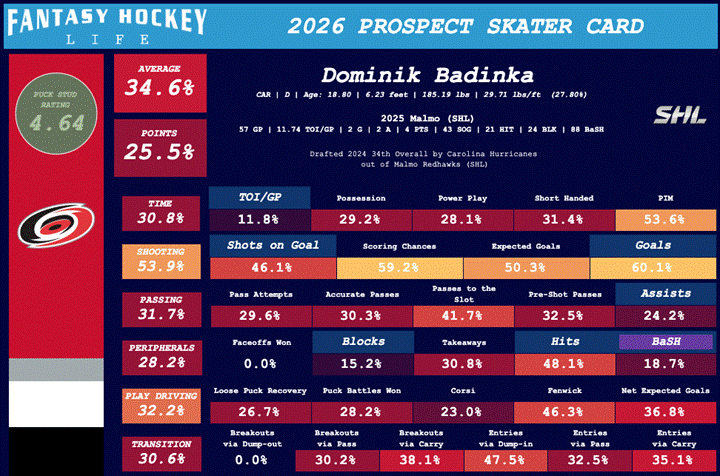
The Jets have opportunities available in their middle six, and the path is there for Lambert to seize a role, but he needs to prove he can be trusted in all situations. His upside is that of a dynamic playmaker who can generate fantasy value, yet he must show that last season’s flashes can translate into sustained, reliable production. Winnipeg is becoming increasingly deep with young forwards, which raises the stakes. This season will go a long way in determining whether he cements himself as a future lineup staple or becomes another high-end tease who never reaches his ceiling.
Carson Rehkopf (F, Seattle Kraken)
Rehkopf lit up the OHL two seasons ago and showcased why scouts are drawn to his shot, goal-scoring instincts, and ability to find soft ice. However, his move from Kitchener to Brampton last season came with a noticeable dip in production, and his pNHLe dropped significantly as a result. That regression raises questions about whether his previous scoring was driven more by volume and usage rather than fully translatable NHL-level skill. There were stretches where he dominated weaker competition, but he struggled to consistently generate offense against tighter checking and structured defenses. As he transitions to the AHL, this season becomes a critical test of whether he can adapt his game to pro pace and pressure and get that pNHLe trending back in the right direction.
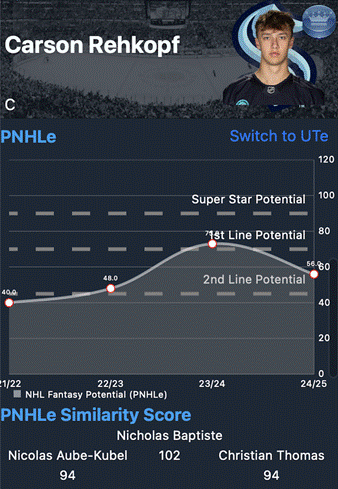
For the Kraken, the opportunity is there if he can round out his toolkit. To earn meaningful NHL minutes, Rehkopf will need to show greater consistency, improved playmaking, and the ability to drive his own line rather than relying on space created by others. His goal-scoring upside is very real, and a power-play role could eventually be in his future, but he must prove he can impact the game at even strength. Dynasty managers should keep him high on the radar because the upside is worth tracking. This season will reveal whether he is a pure finisher who needs support or a more complete offensive threat ready to take the next step.
Dominik Badinka (D, Carolina Hurricanes)
Badinka entered the Hurricanes system as a raw but tantalizing defenseman with size, mobility, and a physical edge. At the J20 level in both Sweden and Finland, he produced well over a half point per game, flashing legitimate puck-moving upside. However, that offense has not translated to the professional level. Across two seasons in the SHL, he managed just 9 points in 82 games, and his Fantasy Hockey Life player card shows he struggled across the board in nearly every major category. While the tools are appealing, he has been inconsistent in his reads and positioning, which has led to defensive lapses and limited trust from coaches.

Carolina values modern, mobile defensemen, but their blue line pipeline is deep and competitive. For Badinka to carve out an NHL role, he must prove he can process the game at pace, improve his decision-making, and become more reliable in his own zone. His size, snarl, and physical presence could earn him a spot as a shutdown option, but without added offense or stronger transitional play, his fantasy ceiling remains low. In dynasty formats, he is a long-term stash with tools worth monitoring, but he will need to take a noticeable step forward soon to stay relevant in a crowded system.
Kalan Lind (F, Nashville Predators)
Lind brings energy, grit, and a relentless motor, flashing the power forward traits that made him attractive on draft day. At his best, he forechecks hard, finishes checks, and creates chaos around the net. However, his offense has stalled. After hovering near a point per game early in junior, his production dropped significantly, and he has now been loaned to the ECHL. His Fantasy Hockey Life profile shows strong hits and blocks, but not much impact in other areas.
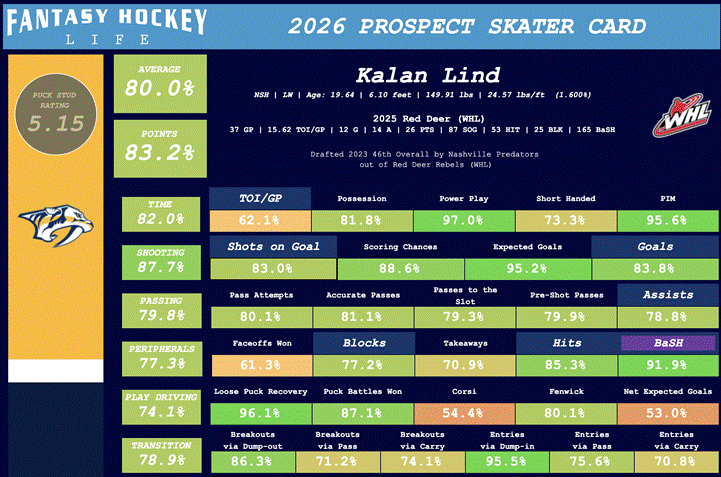
Nashville still values his edge, but he must prove he can be more than a bottom-six grinder. To carve out an NHL role, he needs better structure, discipline, and puck skill so his energy translates into results. The peripheral floor is appealing in deep multicat formats, but without scoring upside, his fantasy value is limited. This season will reveal whether there is middle-six potential here or if he tops out as a depth piece.
Kevin Korchinski (D, Chicago Blackhawks)
Korchinski’s rookie NHL season showed both promise and growing pains. His skating and puck-moving ability are high-end, and at times he looked like the dynamic transition defender Chicago hoped for. However, his defensive awareness and decision-making were inconsistent against top competition. The Blackhawks often sheltered his minutes and leaned on veterans in key situations. After playing 76 NHL games in his draft-plus-two season, he has appeared in only 16 since, and he is now starting this season in the AHL. Meanwhile, Artyom Levshunov, Sam Rinzel, and Alex Vlasic have all passed him on the depth chart and are already in the NHL. This is a massive season for Korchinski, who must prove he belongs.
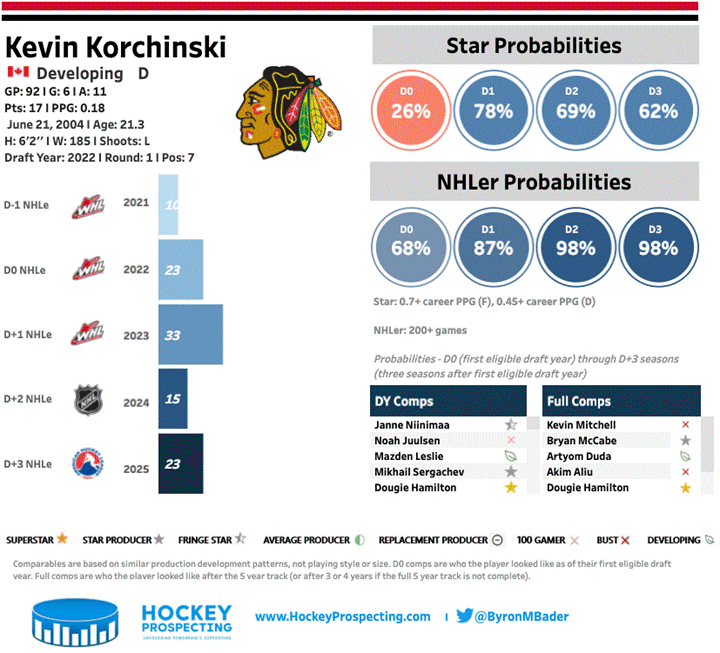
Despite the setback, the long-term upside remains real. Chicago is still rebuilding, and there is opportunity for a young defenseman who can move the puck and produce offense. Korchinski still grades well in the Hockey Prospecting model and he officially graduated from it in his draft-plus-three season with strong long-term indicators. To secure a top-four role, he needs to stabilize defensively, improve his reads, and show that he can handle tougher matchups. If he does, he could earn power-play usage and reclaim his status as a cornerstone piece. If not, he risks settling into a secondary role. For dynasty managers, the ceiling is still high, but this year will be pivotal in determining whether he reaches it.
Matthew Poitras (C, Boston Bruins)
Poitras is a perfect example of how early NHL success can be both a blessing and a challenge. He made the Bruins at 19 and flashed impressive vision and poise, posting respectable production for his age. However, the physical grind and inconsistency eventually caught up with him, leading Boston to send him down for further development. To his credit, he responded exactly how a top prospect should. He dominated in Providence during the 2024–25 AHL season, finishing above a point per game and proving he could drive offense against pros. That breakout made a strong case that he was ready to rejoin the NHL conversation.
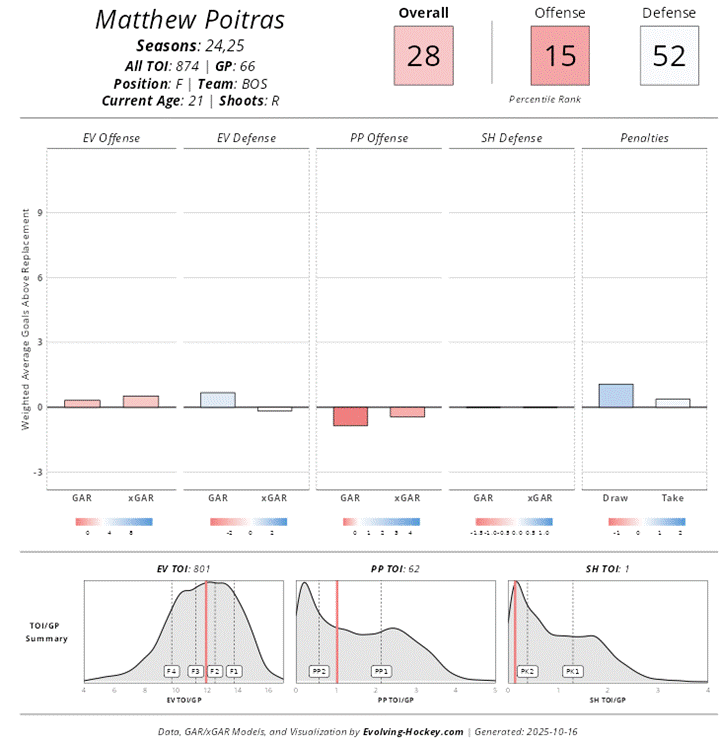
Yet despite that success, he failed to make the Bruins out of camp this season, which adds urgency to his development path. According to Evolving Hockey, his defensive impact is already above average, but his offensive impact has not been strong enough to lock down an NHL roster spot. To get back on track, he needs to rediscover his scoring touch, show that he is too good for the AHL, and carry that confidence into the NHL level. If he can pair consistent production with improved strength, pace, and play-driving ability, he could still force Boston’s hand midseason and reestablish himself as a long-term piece of their core.
Thanks for reading! See you next week. For more fantasy hockey analysis, or if there’s a prospect, topic, or theme you’d like me to cover, follow and message me on X: https://x.com/VictorNuno12

